The NYSCF Conference Returns in Person to Showcase Seminal Advances in Translational Stem Cell Research
NewsOn October 18th and 19th, we hosted the seventeenth annual NYSCF Conference at The Rockefeller University, convening in person again after two years of virtual meetings. Returning to the Caspary Auditorium for two days of groundbreaking translational stem cell science felt like a reunion for many attendees, and reignited the spirit of collaboration and community that characterizes this conference.
NYSCF’s interim CEO Derrick Rossi, PhD, kicked off the meeting by welcoming over 500 participants from academia, industry, government, and nonprofits. Dr. Rossi also reminded attendees of the vision that NYSCF’s late founding CEO Susan Solomon, JD, had for this meeting since launching it in 2006: to serve as a forum for top minds in translational stem cell research to innovate, collaborate, and accelerate towards addressing the unmet needs of patients.
Susan’s vision for this conference was once again realized. The conference featured two inspiring keynote lectures by stem cell pioneers, five scientific sessions, and two panel discussions exploring critical topics in precision medicine and the value of diversity, equity, inclusion, and belonging for our community. We were also proud to announce the 2022 class of NYSCF – Robertson Investigators, welcoming six outstanding stem cell researchers and neuroscientists into the NYSCF Innovator Community. Junior stem cell scientists had a prominent presence as well, showcasing their exciting findings in selected short talks and a lively evening poster session. Read on for highlights!
A Fascinating Journey into the Developing Embryo
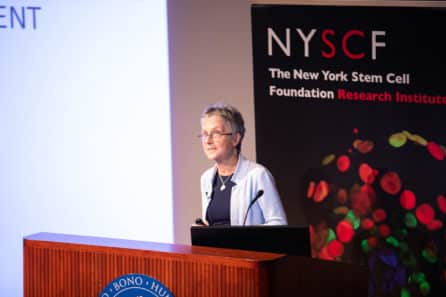
Stem cell pioneer Janet Rossant, PhD, FRS, FRSC, of University of Toronto took the stage as our first keynote speaker to share her impactful journey studying early mammalian development. She described her seminal research on the mouse blastocyst – the hollow sphere containing the first 100 cells of the embryo – and key discoveries about how these cells talk to each other to organize themselves into the structures that eventually become the body’s tissues.
Dr. Rossant also gave a compelling historical overview of the field, from the mid 70’s when she first isolated the inner cell mass of a mouse blastocyst, to the present day, when so many emerging technologies are pushing the boundaries of what’s possible. One of the most insightful parts of her talk was when she highlighted the many ethical controversies that stem cell research has encountered over the years, from the derivation of cell lines from human embryos to the genetic alteration of embryos and gametes, and her central role in taking these on.
Taking on the Challenge of Therapeutic Delivery
Even though progress is skyrocketing in developing powerful molecular therapeutics for a variety of diseases, delivering them to their target cells in a precise and efficient manner remains challenging. In our second keynote, NYSCF – Robertson Stem Cell Investigator Alumnus and CRISPR pioneer Feng Zhang, PhD, of Massachusetts Institute of Technology shared how his lab is exploring the diversity of the natural world to discover systems that can be harnessed for therapeutic delivery.
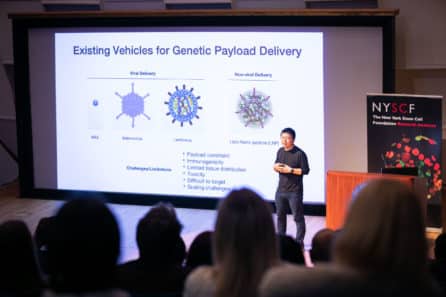
Dr. Zhang described his work on PEG10, a protein found in the human body that normally binds to its own mRNA and forms a spherical protective capsule around it. He explained how his team has managed to engineer PEG10 to package and deliver different RNA cargoes into cells, turning these proteins into delivery vehicles. He also detailed how PEG10 capsules can be decorated with additional proteins called “fusogens” that target capsules to a particular cell or tissue for precise delivery, among several avenues his lab is pursuing for targeted delivery.
The Value of Diversity, Equity, Inclusion, and Belonging for Our Community
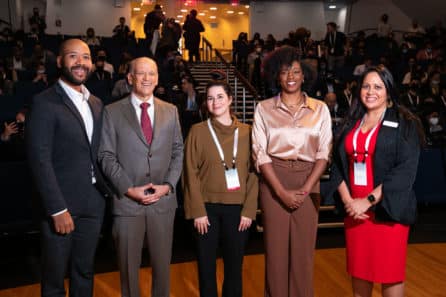
“This conference is such an outstanding showcase of successes in science, but we need to ask ourselves: what goes into those successes? For so many of us from minoritized backgrounds, it takes a lot more to succeed and thrive, because we do not have a level playing field,” said Raeka Aiyar, PhD, NYSCF’s Vice President of Scientific and DEIB Outreach, to kickstart a panel discussion on the value of diversity, equity, inclusion, and belonging (DEIB) for science. “That’s why Susan prioritized inequity as a mission-critical obstacle for NYSCF to remove, because progress will be slowed until all the best minds have equal opportunities to succeed.”
As part of NYSCF’s annual conference spotlight on DEIB, we convened leading DEIB advocates to discuss the benefits that creating inclusive environments can bring to research, labs, our community, and scientific progress writ large. Dr. Aiyar moderated the discussion, starting with a presentation on NYSCF’s efforts to advance DEIB that highlighted recent successes in amplifying DEIB elements in our grantmaking. Panelists Johnna M. Frierson, PhD (Duke University), Christina Termini, PhD (Fred Hutchinson Cancer Center), Ashton Murray, PhD (The Rockefeller University), and Eric J. Nestler, MD, PhD (Icahn School of Medicine at Mount Sinai), outlined rewarding actions that individuals and institutions can take to build a more inclusive and diverse STEM community. They underscored the importance of conscious mentorship and allyship to promote the retention and wellbeing of trainees, the responsibility of institutions in ensuring accountability for detoxifying environments, and the need for more training on mentoring skills.
“What the research shows is that when mentees are in environments where they feel like they can bring their whole selves, where they feel like their race or gender is not off limits, and they have a mentor who they can talk to about these factors, they are more likely to thrive and persist in STEM,” noted Dr. Murray.
Accelerating Precision Medicine with Genomics and Stem Cells
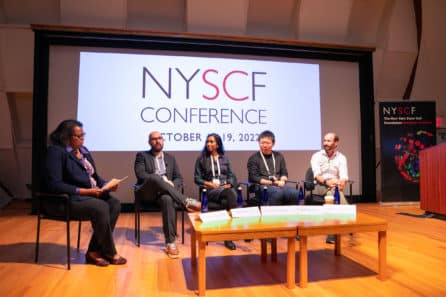
Realizing the promise of precision medicine – i.e. giving the right treatment to the right patient at the right time – is one of NYSCF’s main goals. This is crucial given that many drugs only work for a minority of people who take them. To discuss the success stories and opportunities for bringing the most advanced technologies together to advance personalized health, we convened a panel of leaders in genomics, cell biology, biotechnology and drug development.
Michael Snyder, PhD, of Stanford University School of Medicine, set the scene for the discussion in a plenary lecture about his work to integrate state-of-the-art technologies (genomic sequencing, omics profiling, and wearable biosensors) to quantify and monitor people’s health over time, with the ultimate goal of developing individual baseline measurements and predicting disease before symptoms appear.
Dr. Snyder was then joined by Srilakshmi Raj, PhD (Albert Einstein College of Medicine), NYSCF’s Senior Vice President of Discovery & Platform Development Daniel Paull, PhD, Feng Zhang, PhD (Massachusetts Institute of Technology), and Karen Akinsanya, PhD (Schrödinger), who moderated the discussion. Among many topics, they talked about the opportunities that stem cell technology affords to understand disease heterogeneity across patients, so that we can stratify patient populations and select probable responders for clinical trials, making the trials more likely to succeed. They also highlighted the benefit of studying smaller remote populations to discover rare disease-relevant genetic variants, so that we can learn from them and apply the knowledge to larger populations.
Scientific Session Highlights
Advanced Organoid Models for Disease Research
Chaired by New York University’s Dimitris G. Placantonakis, MD, PhD, this session showcased exciting advances in organoid models (3D structures of human tissue derived from stem cells) and their translational applications.
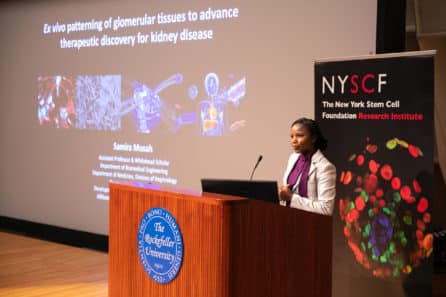
NYSCF – Robertson Stem Cell Investigator Alumna and NYSCF Scientific Advisor Paola Arlotta, PhD (Harvard University) presented her lab’s innovations in generating human cortical organoids with remarkable reproducibility, and their applications of these models to unravel the origins of polygenic neurodevelopmental disorders like autism.
Mandë Holford, PhD (CUNY Hunter College) shared gripping videos of deadly marine snails to showcase the enormous potential that venom holds for biomedical innovation. She also discussed her pioneering efforts to grow venom-producing gland organoids in the lab to study the bioactive properties of venoms and exploit them for therapeutic purposes.
Lastly, Samira Musah, PhD (Duke University) shared her optimized protocols to derive human adult podocytes from iPSCs as well as advances in microfluidic platforms that interconnect different tissues to recapitulate the structural and functional complexity of the human kidney in vitro.
Next-Generation Cancer Immunotherapies
Engineering different facets of the immune system to target cancer was the focus of this session, chaired by Roberta Zappasodi, PhD, of Weill Cornell Medicine.
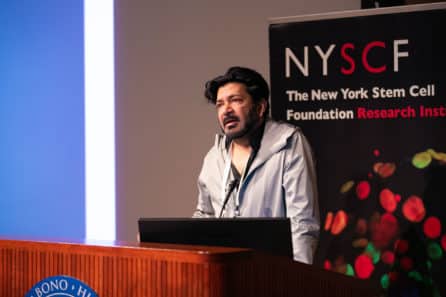
Michael C. Milone, MD, PhD (University of Pennsylvania) shared several of his lab’s strategies to make Chimeric Antigen Receptors (CAR)-T cells more potent against solid tumors, including the development of a KIR-CAR T cell-based therapy which will soon enter clinical trials.
Next, NYSCF Board member Siddhartha Mukherjee, MD, DPhil (Columbia University) described his latest work on an innovative therapy combining gene-edited hematopoietic stem cells and CD33-targeted immunotherapy to treat myeloid malignancies, which has shown remarkable efficacy in the first pediatric cases trialed. He also recounted his efforts to bring the first affordable CAR-T therapies to India, now in phase IIb trials: “I don’t know how to convey to you the pride and joy this gives me.”
Lili Yang, PhD (University of California, Los Angeles) finished the session by discussing her thrust to develop an “off-the-shelf” cancer immunotherapy based on invariant Natural Killer T (iNKT) cells – powerful immune cells that can target cancerous cells without harming the body’s healthy tissues.
Therapeutic Strategies for Diabetes and Autoimmunity
In this session, chaired by type 1 diabetes (T1D) pioneer Kevan Herold, MD, of Yale University, speakers highlighted recent progress in the development of cell and immunomodulatory therapies for T1D and other autoimmune diseases.
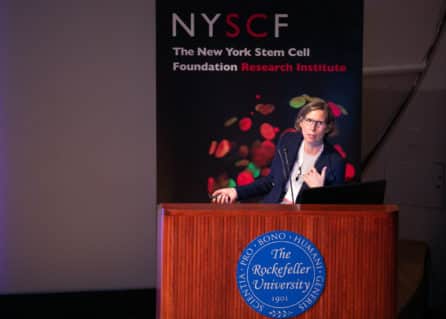
Cherie Stabler, PhD (University of Florida) shared how her lab is engineering solutions to circumvent challenges in islet transplantation therapies, such as developing 3D scaffolds to improve islet engraftment, and encapsulating grafts within biomaterials to mitigate immune rejection.
Qizhi Tang, PhD (University of California, San Francisco) presented exciting updates on a clinical trial testing intramuscular co-transplantation of pancreatic islets and parathyroid glands for the treatment of T1D.
Lastly, Megan Levings, PhD (BC Children’s Hospital Research Institute) discussed her latest work engineering regulatory T cells (Tregs) to express CARs that improve the specificity and function of Tregs and boost their ability to modulate autoimmune responses.
Modeling Complex Neurological Diseases
Chaired by Kelsey Martin, MD, PhD, of The Simons Foundation, this session showcased unique revelations that stem cell models are yielding on how the brain malfunctions in a range of complex neurological disorders.
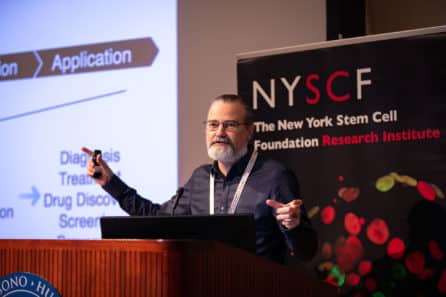
NYSCF’s Senior Vice President of Research Scott Noggle, PhD, discussed how population-scale biology enabled by NYSCF’s automation technology for iPSC culture and differentiation is uncovering novel hallmarks of Parkinson’s and post-traumatic stress disorder that are now being leveraged to discover new treatment options.
NYSCF – Robertson Stem Cell Investigator Alumna Kristen Brennand, PhD (Yale University) presented several examples of how her lab is using stem cells to elucidate the effects of genetic variants associated with neuropsychiatric disorders on specific brain cells.
Lastly, we learned about the latest inroads NYSCF – Robertson Stem Cell Investigator Vikram Khurana, MD, PhD (Brigham and Women’s Hospital) is making into Parkinson’s disease heterogeneity by creating unique genetic stem cell models. He also shared how his earlier work on yeast models led to the identification of a potential therapeutic compound to combat the cytotoxic effect of α-synuclein accumulation observed in Parkinson’s patients.
Emerging Cell Therapies
The last scientific session of the conference, chaired by Lorenz Studer, MD (Memorial Sloan Kettering Cancer Center), highlighted three examples of stem cell-based cell therapies in or nearing clinical trials.
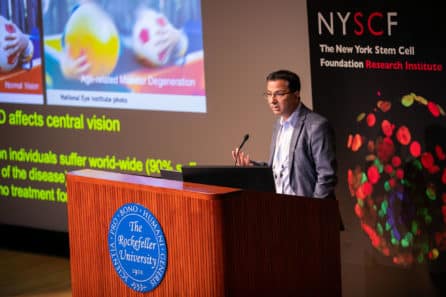
NYSCF – Robertson Stem Cell Investigator Alumna Malin Parmar, PhD (Lund University) discussed how she is using single-cell omics to characterize the composition of grafts containing ESC-dopaminergic neurons being developed as a therapy for Parkinson’s disease. She also provided updates on the investigational stem cell-based therapy for the treatment of Parkinson’s disease that she leads (STEM-PD), which was recently given regulatory approval for a Phase I/IIa clinical trial in Sweden.
Mathew Blurton-Jones, PhD (University of California, Irvine) presented his latest preclinical work exploiting iPSC-derived microglia to deliver therapeutics to the brain, and showed that this treatment modality can lead to a promising reduction of amyloid pathology in the brains of Alzheimer’s disease mouse models.
Finally, Kapil Bharti, PhD (National Eye Institute, NEI) shared his years of work to develop an iPSC-derived retinal pigment epithelium (iRPE) patch to treat dry age-related macular degeneration (AMD), and how he is leveraging image-based artificial intelligence tools to assess the quality of the patch. Dr. Bharti’s autologous stem cell therapy reached its first U.S. patient as part of a phase 1/2a clinical trial two months ago. We have licensed his technology to generate clinical-grade iRPE patches in our new GMP facility and are working towards a parallel clinical trial in partnership with Columbia University to broaden access to this promising therapy.
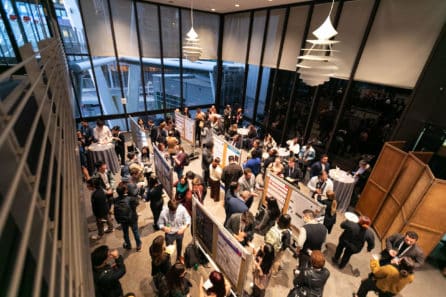
We are so grateful to everyone who participated in the conference! It was fantastic to share the excitement of stem cell science in person again, and we hope to see many of you at next year’s conference (stay tuned for details)!

